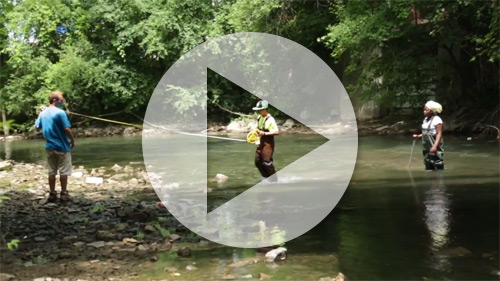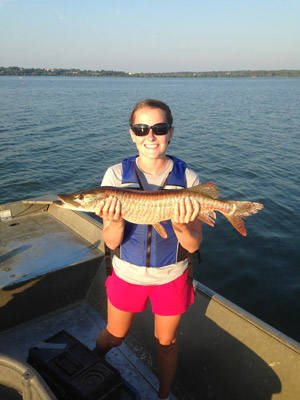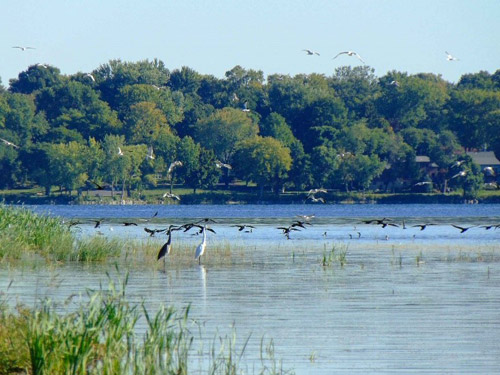Thousands of Central New Yorkers Enjoy Learning About Outdoor Sports While Celebrating National Hunting and Fishing Day
Thousands of people learned about outdoor recreational activities, and habitat and wildlife conservation, during Honeywell Sportsmen’s Days at Carpenter’s Brook September 22 and 23. The annual event, which features activities including fishing, archery, canoeing, turkey calling, and skeet shooting, is hosted by the Onondaga County Federation of Sportsmen’s Clubs and is a celebration of National Hunting and Fishing Day.

Left: Cousins Camden Davis (front), of Baldwinsville, and Ben Benson, of Syracuse, paddle a canoe in the pond at Carpenter’s Brook Fish Hatchery.
Right: Six-year-old Grayson LaGrow, of Skaneateles, holds a trout caught in the public fishing pond at Carpenter’s Brook Fish Hatchery.
Attendees learned about progress achieved on habitat restoration as part of the Onondaga Lake cleanup. They also learned how to join the Onondaga Lake Conservation Corps, an expanding organization of community volunteers who are contributing to restoration projects that are creating or improving habitat for fish, birds, and other wildlife in the Onondaga Lake watershed.

Left: “This is the first time we’ve attended this event,” said Heather Williams (left), of Red Creek, pictured with 4-year-old Jayce and husband Dylan. “We participate in outdoor recreational activities and it was nice our son could learn from outdoors experts at Honeywell Sportsmen’s Days.”
Right: Honeywell Syracuse Program Director John McAuliffe (right) baits his hook while visiting with volunteer Joan Gilfilian, of Marietta.
“Local habitat and conservation groups, including the Onondaga County Federation of Sportsmen’s Clubs, have provided valuable input to Honeywell about opportunities to increase recreational use of Onondaga Lake and its tributaries,” said McAuliffe. “We are now seeing the results in areas like Nine Mile Creek, which has become a thriving ecosystem that is open to the public for canoeing and kayaking.”

Left: Onondaga County Federation of Sportsmen’s Clubs President Tom Merrill (right) and McAuliffe (center) greet participant John Sharon (left), of Jamesville, at Honeywell Sportsmen’s Days.
Right: Thirteen-year-old Allison Dougherty, of Liverpool, learns how to use a crossbow from Onondaga County Parks Commissioner Bill Lansley.
Local wildlife artists, woodsmen, authors, and sports enthusiasts presented a number of outdoor activities including: canoeing, skeet shooting, waterfowl and turkey calling, archery, crossbow, fly fishing, fly tying, muzzle loading, and trout fishing. Other weekend events included guest appearances by conservation officers and forest rangers.
“The Onondaga County Federation of Sportsmen’s Clubs, in cooperation with the Onondaga County Parks Department, and with continuing support from Honeywell, proudly presents Honeywell Sportsmen’s Days at Carpenter’s Brook Fish Hatchery,” said Onondaga County Federation of Sportsmen’s Clubs President Tom Merrill. “Thanks to our member clubs and organizations we are able to produce this event, giving people of all ages and backgrounds a chance to try outdoor activities while providing them with an opportunity to learn about improvements to our local environment.”

Left: Seven-year-old Brielle Buxton (center), of Cicero, checks out a pelt at the living history site with her mom Colleen Buxton (right) and brother Owen (left), 8.
Right: Seven-year-old Maddison Perkins, of Syracuse, tries archery with help from Mark Schmid, of the Pompey Rod & Gun Club.
View more photographs of Honeywell Sportsmen’s Days at Carpenter’s Brook.
For more information on the Onondaga Lake cleanup, please visit www.lakecleanup.com.





































